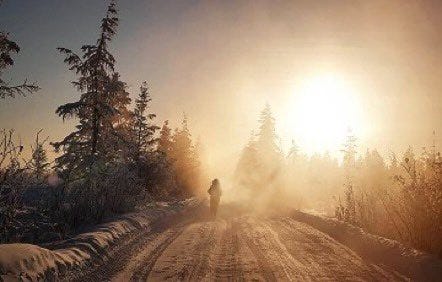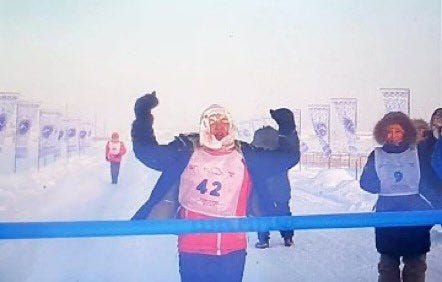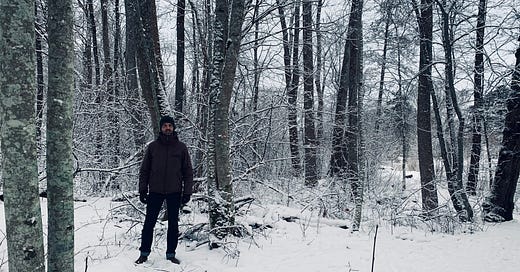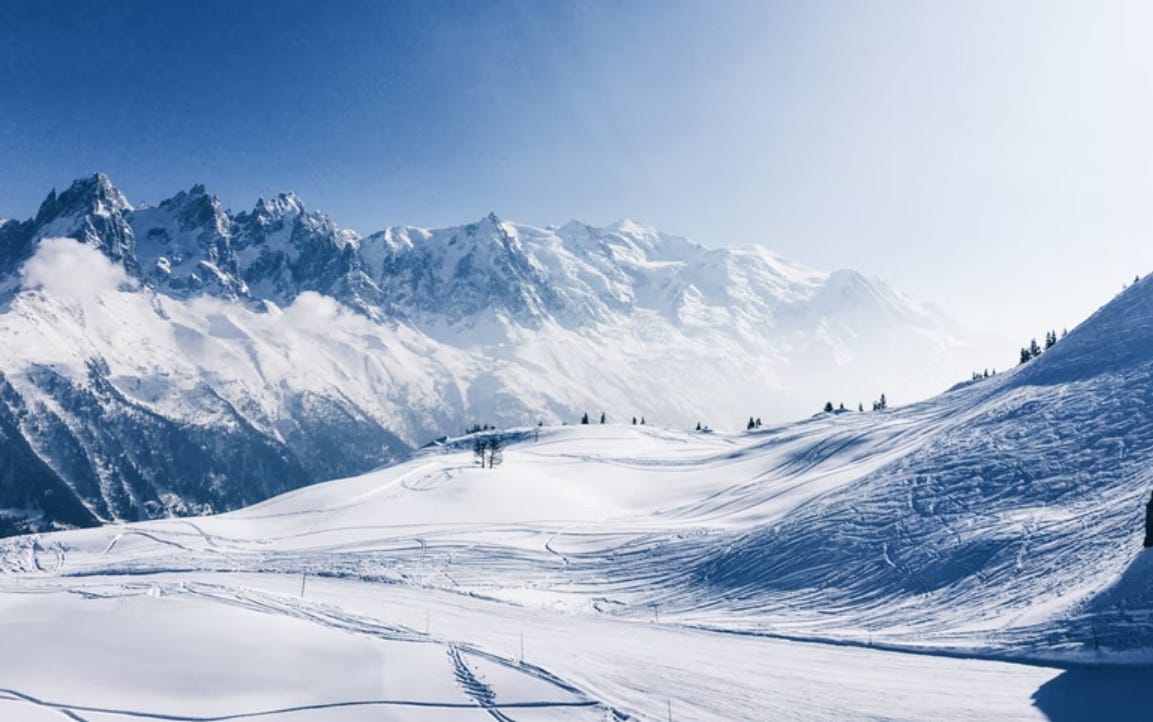Winter Weather Review
Snowfall and cold temperature records continue to be broken around the World...
‘‘65 participants took part on the ‘Pole of Cold Marathon’ race in Siberia this January during -53 Celsius conditions, confirming it’s place in the Guinness Book of Records as the World’s coldest ever race!’’
DISCLAIMER: An imbalance in weather reporting has, in my opinion, reinforced in many the impression that it is just fire and brimstone from here on out as we accelerate towards our impending climate catastrophe born of cow farts and coal mines. So, as with all of my seasonal weather reviews, I deliberately focus on those stories that emphasize the colder end of the spectrum.
When researching news reports for this latest seasonal weather review, I was struck by the number of snowfall incidents hitting the headlines. From well-known winter-wonderlands such as the European Alps and the Californian Mountain Ranges, to more surprising regions such as Saudi Arabia and even the Sarah Desert, it has been a record-breaking season on many fronts!
I’ve not been able to include them all in this newsletter, but my aim is to give you just a flavor of just how widespread these record-breaking cold and snow conditions were in the winter of 2021/22…
USA
In the middle of December, regional snowfall records were broken with as much as 8 feet falling along California’s Sierra Nevada mountain chain.
Impressive totals were were recorded across Nevada with the towns of Ely, Eureka, Winnemucca and Tonopah, all breaking local records. For example, Winnemucca broke it’s all-time record set back in 1889 for the date, and Ely breaking its 2012 record by almost double.
At the end of December low temperature records were set including NW Seattle’s -5.6 C, breaking the city’s 1924 record and nearby Bellingham which broke it’s previous 1971 record with a chilly -12.8 C.
Back in California and the mountains continued to witness their snowiest December on record, with snow pack levels beating the record that had stood since 1971.
Moving into early January, 2022 and Buffalo, New York, broke its single day snowfall record by more than double, a record that had stood since 1974, and an all-time January day snowfall record was also broken in nearby Cheektowaga.
In Wenatchee, WA, the all-time 24-hour snowfall record was smashed with between 23 and 25 inches falling, breaking the previous record of 16.5 inches set in 1971.
Elsewhere in Washington State a record 236 inches of snow fell, breaking the previous 2006 record of 229 inches. Around 40 avalanches came down around Snoqualmie, causing the transportation department to conduct extensive clearing operations.
Elsewhere in the USA throughout January, various snowfall records were broken at;
Ronald Raegan and Dulles Airports, Virginia;
Buffalo, New York;
Asheville, North Carolina;
Nashville, Tennessee;
Charlotte, North Carolina;
Mount Sunflower, Kansas;
Boston, Stoughton and South Shore, Massachusetts; and
Providence, Rhode Island.
In Alaska, Petersburg recorded the most snowfall and highest depth ever recorded on January 1st of any year - 17.5 inches - just short of the most snowfall ever recorded on a single day in the month of January, set in 1971.
As well as record snowfalls, record cold temperatures were also seen at places including north east West Virginia, where a weather station in Canaan Valley plunged to -35 Celsius, the coldest reading on record.
While sounding balmy compared with other locations across the continent, Tallahassee, Florida, dipped below 20 degrees for the first time in more than 10 years, and the Florida Keys Marathon International Airport broke a cold record set more than 65 years ago.
Yet more record snowfall events were being chalked up into early February including a snowiest February day seen in Lansing, Michigan, and a 109-year record broken in Wichita, Kansas. A single-day snowfall record that had stood since 1913 was broken twice on consecutive days in Oklahoma City. And Indianapolis broke a snowfall record that had stood since 1982.
And in late February, while many people in the Northern Hemisphere are longing to welcome back the springtime, winter conditions continued to persist!
Kansas City broke a 129 year-old snowfall record, and Denver experienced its snowiest start to a year since its records began back in the late 1800’s as well as a slew of historic cold temperatures.
Europe
On the last day of November, the southeastern French city of Grenoble recorded a record breaking low temperature of -10 Celsius, the city’s lowest recorded temperature in half a century.
On the same day in Italy a record low of -15 Celsius was recorded in the northwest of the country in the Fusine region, also contributing to heavy snowfall in the area.
Sweden’s cold winter set in very early, with a bone crunching -43.8 Celsius being announced by the Swedish national weather agency recorded in Naimakka. This was the lowest December temperature since 1986, and not far away from Sweden’s official all-time record low of -48.9 Celsius from Hemavaan set in 1978.
Continuing into December and the French Pyranees were seeing among their highest ever December accumulations of snow; Arette La Pierre Saint Martin set a new benchmark for the month of December; Cauterets’ observation network post set a new record for the month; and Lac d’Ardiden saw the area’s highest December snowfall since weather stations opened there some 25 years ago.
Late in December, shifting to Switzerland, the famous ski resort of Chamonix saw snowfall not seen since the 1960’s, claiming over 85 cm.
January 2022 saw more record snow and cold conditions not least those recorded in Greece - a place not usually associated with such conditions. Mykonos saw a covering of snow which is a rare event for the Mediterranean island, the last time being ‘decades ago’ according to local reports.
In Athens, historic totals of 50 cm and more were documented, with Greece’s snow over this period being described as the heaviest since at least 1968. In the nation’s mountainous valleys, record lows have been observed of between -20 and -25 Celsius.
In what local media outlets labelled as a “once in a lifetime phenomenon”, sea ice formed off the coast of Greece as the country continued to be ravaged by record snow and cold conditions. Meteo.gr reported that 288 of its meteorological stations in Greece had logged freezing temperatures, of which 44 had recorded readings below -10 Celsius. The lowest value was a record breaking -18.1 Celsius in Lefkochori, Fthiotida.
Middle East and North Africa
Not often associated with cold and snow conditions, it seems that not even Arabian, Persian and North African regions were spared during the winter of 2021-22!
Towards the end of January, parts of the Sahara Desert turned white and temperatures dropped to below freezing in places such as northeast Algeria; this particular part of the Sarah Desert only seeing snow on five occasions in the last 43 years (interestingly, four of which being in the last six years).
Such amazing conditions have been the backdrop of some spectacular sights, as caught on camera by the photographer Karim Bouchetata, for example:
In the Lebanese mountains around the same time, lows touched a bone-crunching -27 Celsius.
Extreme lows of around -23 Celsius were reported in the Iranian mountains; and a low of –27.4C in Saqqez, Kurdistan province. In Damascus, Syria, an exceptionally cold -8 Celsius was recorded.
In Jordan, record low temps were claimed, with Safawi dropping to -5 Celsius.
Turaif in Saudi Arabia reported an exceptionally low -6 Celsius, the Kingdom’s coldest low since 1992; and while to many this may seem quite mild for a winter recording, Makkah registered a very low daily maximum of just 24 Celsius.
Elsewhere in the Arabian Gulf places such as Oman, Qatar and the UAE also reportedly chalked up record-cold conditions.
At the end of January, Iran and Iraq suffered record low temperatures of -27.4 Celsius and -30 Celsius respectively.
Roundup from Elsewhere
A quick round-up of yet more record-breaking wintery conditions from around the world includes:
The Russian city of St Petersburg broke a daily record of -21 Celsius in early December that had stood for 128 years.
In late December, the Indian city of Bhopal dropped to 4 Celsius, the coldest since 1966, while in Japan, Hikone and Asago saw Japan’s highest ever snowfall. At around the same time Seoul, South Korea, residents experienced the capital’s coldest December day for more than 40 years after dropping to -16 Celsius.
China saw many records set including a number of all-time cold temperatures set at places including;
Tuli River at -42 Celsius;
Fuyuan at -42.3 Celsius;
Wuying at -43.3 Celsius;
Jiayan at -44.4 Celsius; and
Hulunbuir at -46.9 Celsius.
The ‘Pole of Cold Marathon’ race in Siberia this January saw 65 participants taking part in incredible -53 Celsius conditions, which confirmed it’s place in the Guinness Book of Records as the coldest race in the World!





In late January and early February in the Indian regions of Bhopal and Indore, 18 out of 33 weather stations recorded record low temperatures, and Delhi recorded it’s coldest February day in almost 20.
The Cuban Havana Marti International Airport saw it’s lowest temperature since 1940.
Sukayu, in Japan saw it’s largest January total snowfall since records began in 1980 and Chitose tied the areas all-time low temperature record of -25.4 Celsius.
In late February, British Columbia in Canada saw a day in which at least 17 cold temperature records were broken across the province the oldest of which had stood for more than a hundred years.
And finally, the Chinese city of Xiamen, Fujian Province, witnessed extremely rare snow as flakes fell for the first time in 129 years!
What’s Next?
The ‘meridional flow’ discussed in previous Autumn Weather Review provides a brief explanation as to the cause of these extreme conditions being reported pretty much wherever such conditions are monitored.
This explanation ties in with the weak solar activity that we are seeing in our current solar cycle discussed in my Cosmic Rays newsletter last month, which itself provides an additional theory as to why average temperatures may be falling.
Only time will tell.
As ever, I expect I will have no shortage of cold weather stories to report on in the next seasonal weather report!
I hope you enjoyed!
-Tristan





